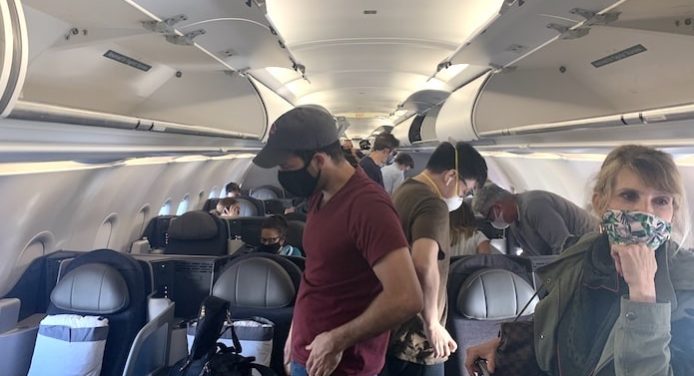By David DeVoss
Covid-19. Shuttered bars and restaurants. Urban lockdowns. Mask fatigue. Curfews. Canceled holiday gatherings. Want to get away? Well, why not? There’s never been a better time to travel. Like anything, there are risks and benefits to global travel during a pandemic.
There are bargains everywhere you look. Want to fly from New York to Nashville for Christmas? In 2019 a rountrip cost more than $300. This year: $71. Roundtrips from Chicago to Las Vegas at the end of the year can be had for as low as $81. Last year’s price was more than $350. Roundtrips from the West Coast to Hawaii can be found as low as $161.
Alaska Airlines, which blocks middle seats to achieve social distancing, currently is offering a buy-one-get-one free offer for tickets sold between now and mid-December. It means you and a companion can have an entire row to yourselves for the price of a single ticket.
International travel is even more of a bargain. Between now and the end of May 2021, Dubai-based Emirates airline is subtracting an additional 10% off its already discounted fares. Roundtrip business class fares between the U.S. and Middle East are 70% off.
Bargain packages are fleeting. Most appear on the Internet one day and expire 48 hours later. But for the moment deals like those described above can be found with diligent browsing.
Hotel and luxury tour packages are the lowest they’ve been since 2001. For $999 two people can spend a week in Bali’s Nusa Dua at a 5-star villa with a private swimming pool. For half that sum it’s possible to fly to Costa Rica and stay at a beach resort and a jungle villa. Ever been to the Maldives? Well, now you can go and stay on your own private island for $1,899. And, yes, airfare plus all meals and beverages are included. But what happenes if the coronavirus spikes again and borders close? Not to worry since all hotel charges and agency fees paid in advance will be refunded.
With deals like these hotels and airplanes should be filling up. Unfortunately, that’s not happening. According to a nationwide survey conducted last week by the American Hotel & Lodging Association, 7 out of 10 Americans have no plans to travel between now and the end of the year. Indeed, 44% say it probably will be a year or more before they take a leisure trip and stay in a hotel.
After shutting down the cruise industry last spring, the Centers for Disease Control and Prevention last week lifted its “no sail” order, despite confirmed cases of Covid-19 exceeding 9,000,000 nationwide. This means that come December 1st large companies such as Carnival, Royal Caribbean and Norwegian Cruise Line Holdings can begin the long process necessary to resume sailing. The CDC wanted to extend the no sail directive into February but was overruled by the White House, which wants to reduce financial stress on companies like Royal Caribbean that recently posted a quarterly loss of $1.3 billion.
Cruise lines will incur significant expense once they resume sailing. Voyages must be less than one week in duration and ships must test all passengers and crew for Covid-19 on embarkation and disembarkation. Cruise operators also need signed agreements from every port-of-call that certify their visits will not unduly burden the local medical infrastructure.
Rapid development of coronavirus vaccines by Moderna, Pfizer and AstraZeneca has buoyed the stock prices of America’s airlines, but the prospect of a cure has not restored confidence in flying. America’s six largest airlines had combined losses of $22.5 billion during the second and third quarters of this year. The number of paid-ticket passengers carried by American, United and Southwest is down 67% compared to the year before. There was a slight uptick in travel in mid October when TSA screened more than one million passengers, but the rebound in travel failed to materialize. According to Cirium, an aviation data company, 31% of the world’s commercial airliners remain grounded.
Desperate to get customers back aboard planes often flying 50% empty, airlines are happily redeeming frequent flyer miles for premium destinations. In the past, United demanded 25,000 miles to fly between its 10 busiest domestic markets. Today you can get the same ticket for 12,850 miles. Comparison shopping is essential but using miles to travel can be a better bargain than buying a deeply discounted cash ticket.
The savings can be even better on seats in the front of the plane. Because corporate executives are staying at home and conducting conferences on Zoom, business travel is down 85%. The best seats on many transcontinental flights literally are empty. Last month on the New York to Los Angeles route American was asking only 46,300 miles for a roundtrip business class ticket. The cash price for the same seat on the same flights would have been $1,400.
Great deals only make sense if the ticket you buy takes you to a city that’s open for business. The majority of Asian-Pacific countries remain effectively closed to foreign tourists. Visitors to many Asian destinations (Hong Kong, South Korea, New Zealand) are subject to mandatory two-week quarantines. Singapore arrests and jails tourists who leave quarantine for a breath of fresh air or disregard social distancing rules.
Tickets to Europe have never been cheaper but what do you do once you arrive? France and Spain both have nationwide curfews and Ireland recently reinstated a partial national lockdown.
Why not take advantage of cheap airfares and fly to Hawaii? Daily arrivals are down from 30,000 to 6,000 because of the pandemic, so there’s plenty of space. Unfortunately, many of Oahu’s attractions are closed. The Diamond Head State Monument and the Polynesian Cultural Center both are shuttered. So is Hanauma Bay Nature Preserve that formerly offered the best snorkeling on the island. It’s still possible to stroll on the sand of Waikiki Beach, but the thrice-weekly hula performances on Kuhio Beach have been suspended until the end of the year due to social distancing requirements.

The walk-through HandiChannel can sanitize people and belongings. Photo: HandiGroup
Caution on the part of public officials is justified and few families want to climb on a plane when public health experts say we are living through “Covid Hell!.” But the fact is that commercial aircraft never have been cleaner. Airports, too, wll be able to make that claim as more install the HandiChannel, a walk-through sanitizing device, which uses ultraviolet light to effectively kill 99.999% of bugs and viruses, including the one which causes COVID-19.
For healthy travelers who wear masks, airplanes are among the cleanest places you can be. This claim was verified recently by a Department of Defense study on how virus particles spread during a flight.
Using coughing mannequins that expelled florescent tracer particles in a Boeing wide-body jet borrowed from United, the study found that aerosol particles are quickly captured by standard jet ventilation systems with state of the art air filters. Exposure risk is minimal even for passengers on long flights seated next to an infected person. Concluded the Washington Post, “you would have to be sitting next to an infectious passenger for at least 54 hours to receive a dangerous dose of the virus through the air.”
Since the longest commercial airline flight from New York to Sydney on Quantas only takes around 19 hours, people wearing masks probably are safe on airplanes.
“My sense is that people are getting increasingly comfortable with how safe air travel and hotels are, and the precautions that the industry has been taking,” Expedia CEO Peter Kern recently told Bloomberg News. “Travel is a force for good and we want to help people go where they want to go.”
Travel is much more than a force for good. Prior to the coronavirus, the tourism industry generated 10.5% of the world’s total economy and accounted for one out of every 10 jobs. In the U.S., travel and tourism supplied more than $1.6 trillion in economic output and supported 7.8 million jobs.
Today this same industry is projected to lose between $910 billion to $1.2 trillion by the end of the year. While travel probably will rebound by the second quarter of 2021, airlines, hotels and tour companies need revenue now. Unable to secure a second federal bailout, airlines are dropping prices, hospitality companies like Premier Hotels and Resorts are discounting by 30% the cost of rooms reserved now for occupancy during the Christmas holidays and agencies like Travelocity are offering to refund the room costs if prospective occupants cancel the reservation early.
Each of us has a different tolerance for risk and given the recent spike in infections many will decide to forego holiday travel. But think twice before passing up the current crop of travel bargains. Once vaccines are approved for public use and vaccinations begin, low hospitality rates and mileage redemption opportunities will disappear.![]()
David DeVoss is the editor of the East-West News Service.


